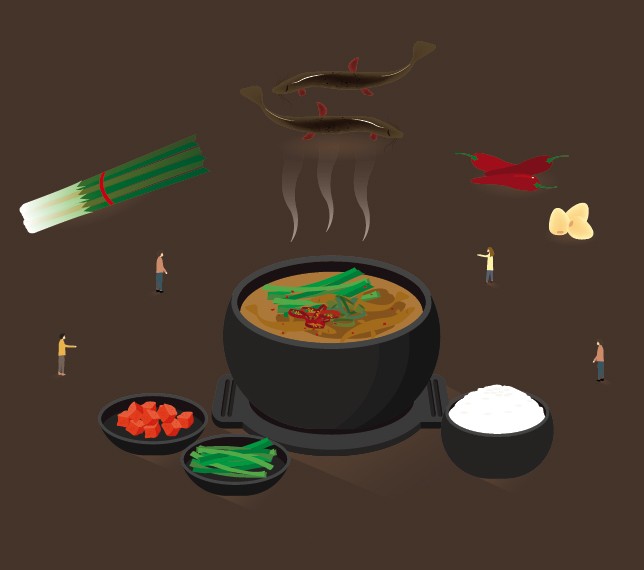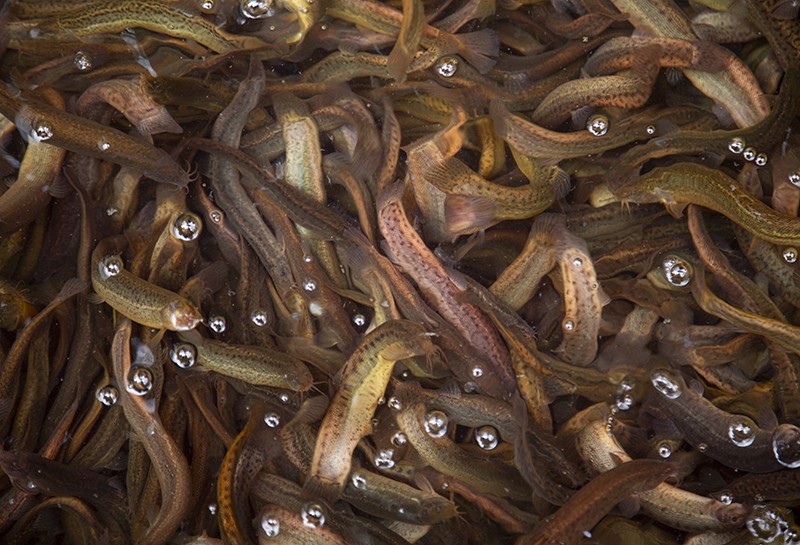한식 읽기 좋은 날
Vol 53. Korean Food from the Oceans and Rivers
The Joy Provided by the Mikkuraji
HANSIK at the Sayings
As indicated by the expression “one mikkuraji (loach) muddies the entire pond,” most Korean sayings about the loach are negative. Indeed, according to the National Institute of Korean Language’s Standard Korean Language Dictionary, the loach is used as a metaphor to describe “someone who is highly capable of escaping from situations that he or she judges are not beneficial to oneself.” This cannot be anything but a travesty for the real-life loach—especially given the fact that it is not only a widely-used ingredient but also benefits humans in many other ways (e.g. removing pollutants from wastewater, organic farming).
Article Noh Yunyoung (Editorial Team) Source Encyclopedia of Korean Culture, Wikipedia Korea

Does a loach really muddy its waters?
The loach is a freshwater fish that is a member of the Cobitidae family. Its body is, at 10 to 20 centimeters, thin, long, and covered in small blurry dots (except for the head and belly). Generally bluish-black in color, the loach’s head is slightly flattened vertically.
They live wherever there is a lot of damp soil, such as swamps, rice paddies, and rice paddy waterways, and can endure dirty water and even shortages of oxygen. They can be seen when they occasionally come to the surface to breathe: the reason is that loaches, unlike most fish (which breathe through their gills only), are also capable of intestinal respiration. This is how, even in muddy waters that do not contain much oxygen, the loach can survive by opening its mouth to breathe at the water’s surface.
The loach hunts at night, usually for algae or small organisms stuck to the muddy floor. It also occasionally eats sprouts, fruit, or soil sediment. Loaches live in the largest numbers in southwestern Korea but can be found nationwide, usually downstream and in places where water flow is very slow or stagnant (e.g. ponds, ridges between rice paddies, ditches, rural waterway passages). When temperatures drop or a drought occurs, loaches burrow deep inside the damp soil to hibernate.

The falsely-accused loach
As mentioned earlier in this article, the loach is often the subject of pessimistic sayings and maxims. Even the saying “a loach turned into a dragon” is based on associating someone with humble beginnings—in other words, not having much material wealth—to a loach. The saying “burping loudly after eating loach stew” has the same context, denigrating a person of humble means who tries to look more prominent than he actually is. “Pouring a jar of water on one loach” is a sarcastic way of referring to someone who presents oneself to others in a way that does not befit one’s circumstances.
Other sayings include the frequently-used “a dragon that falls into a stream becomes a loach,” which implies that a person who has fallen on hard times will be scorned like a loach, and “one loach muddies an entire pond,” which means that one wicked person or family can cause lasting damages to a society. The many other sayings about the loach stray very little from this implication—that, with its thin, slippery body, the loach can go wherever it wants or survive even in dirty water.
Ironically, it is this hardiness that makes the loach a significant contributor to the preservation of ecosystems. One loach can eat 1,100 mosquito larvae per day and, by frequently digging up wetland sediment, supplies oxygen to streambeds, which improves water quality and plays a key role in stream purification. Loaches are also used in organic farming methods: releasing loaches into a rice paddy results in more oxygen suppliedto the rice stalks (because of the loaches’ tendency to dig into the soil), making them sturdier. Also, loaches eat weed sprouts, thereby eliminating the need for herbicides.
As a food, the loach is a treasure trove of nutrients. Bencao Gangmu, a medical encyclopedia compiled by Li Shizhen in the Ming dynasty based on documents and Li’s personal observations on medicinal herbs, describes the loach as “beneficial for one’s yang energy, able to turn white hair black, most delicious when grilled over a small fire, and beneficial for sexual virility.”
In an age in which meat was not as common as it is today, the loach, which is rich in protein, vitamin A, and minerals, was a major source of animal protein. Half of its protein content is comprised of essential amino acids: there is also a large quantity of lysine, which is good for seniors and growing children. Its taurine also protects the liver and intestines, lowers blood pressure, and protects eyesight. The loach’s fat is mostly unsaturated, making it an effective nutritional supplement that prevents adult diseases.
Koreans have used the loach as a nutritional snack or meal since antiquity. It is a popular ingredient of chueotang (loach soup) and also enjoyed fried in a light batter. When used in food, loaches are soaked in water for several days to remove their odor and then sprinkled in salt (to remove sediment).
As such, contrary to folk wisdom and its continued use as the subject of pessimistic sayings, the loach is advantageous to both people and the ecosystem. One saying about the loach goes: “after 1,000 years as a loach, one can become a dragon.” This means that, after years of sincere effort, one will eventually achieve success. As with the sayings mentioned beforehand, this one is based on the mistaken notion that the loach is, at best, a humble creature. The dragon is an imaginary animal, but the loach is very much real and makes similarly substantive contributions to our lives. Perhaps now is the time to learn the value of the loach, which enriches our daily routines, rather than that of the dragon, which disappears into an unreachable heaven.

 한국어
한국어
 English
English






